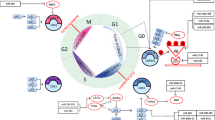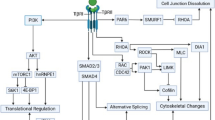Abstract
Epithelial-mesenchymal transition (EMT) is crucial for specific morphogenetic movements during embryonic development as well as pathological processes of tumor cell invasion and metastasis. TWIST and SNAIL play vital roles in both developmental and pathological EMT. Our aim in this study was to investigate the functional correlation between TWIST1 and SNAIL in human ESCC cell line (KYSE-30). The packaging cell line GP293T was cotransfected with either control retroviral pruf-IRES-GFP plasmid or pruf-IRES-GFP-hTWIST1 and pGP plasmid. The KYSE-30 ESCC cells were transduced with produced viral particles and examined with inverted fluorescence microscope. DNA was extracted from transduced KYSE-30 cells and analyzed for copy number of integrated retroviral sequences in the target cell genome. The concentration of retroviral particles was determined by Real-time PCR. After RNA extraction and cDNA synthesis, the mRNA expression of TWIST1 and SNAIL was assessed by comparative real-time PCR amplification. Ectopic expression of TWIST1 in KYSE-30, dramatically reduces SNAIL expression. Retroviral transduction enforced TWIST1 overexpression in GFP-hTWIST1 nearly 9 folds in comparison with GFP control cells, and interestingly, this TWIST1 enforced expression caused a − 7 fold decrease of SNAIL mRNA expression in GFP-hTWIST1 compared to GFP control cells. Inverse correlation of TWIST1 and SNAIL mRNA levels may introduce novel molecular gene expression pathway controlling EMT process during ESCC aggressiveness and tumorigenesis. Consequently, these data extend the spectrum of biological activities of TWIST1 and propose that therapeutic repression of TWIST1 may be an effective strategy to inhibit cancer cell invasion and metastasis.



Similar content being viewed by others
References
Gavert N, Ben-Ze'ev A (2008) Epithelial-mesenchymal transition and the invasive potential of tumors. Trends Mol Med 14(5):199–209
Tsuji T, Ibaragi S, Hu GF (2009) Epithelial-mesenchymal transition and cell cooperativity in metastasis. Cancer Res 69(18):7135–7139
Batlle E et al. (2000) The transcription factor snail is a repressor of E-cadherin gene expression in epithelial tumour cells. Nat Cell Biol 2(2):84–89
Cano A et al. (2000) The transcription factor snail controls epithelial-mesenchymal transitions by repressing E-cadherin expression. Nat Cell Biol 2(2):76–83
Hajra KM, Chen DY, Fearon ER (2002) The SLUG zinc-finger protein represses E-cadherin in breast cancer. Cancer Res 62(6):1613–1618
Eger A, A.K., Sonderegger S, et al. (2005) DeltaEF1 is a transcriptional repressor of E-cadherin and regulates epithelial plasticity in breast cancer cells. Oncogene 24:2375–2385
Comijn J, Berx G, A. A e, Vermassen P (2001) The two-handed E box binding zinc finger protein SIP1 downregulates E-cadherin and induces invasion. Mol Cell 7:1267–1278
Yang J et al. (2004) Twist, a master regulator of morphogenesis, plays an essential role in tumor metastasis. Cell 117(7):927–939
Sosic D, EN O (2003) A new twist on twist--modulation of theNF-kappa B pathway. Cell Cycle 2:76–78
Maestro R et al. (1999) Twist is a potential oncogene that inhibits apoptosis. Genes Dev 13:2207–2217
Connerney J et al. (2008) Twist1 homodimers enhance FGF responsiveness of the cranial sutures and promote suture closure. Dev Biol 318(2):323–334
Firulli AB, Conway SJ (2008) Phosphoregulation of Twist1 provides a mechanism of cell fate control. Curr Med Chem 15(25):2641–2647
Connerney J et al. (2006) Twist1 dimer selection regulates cranial suture patterning and fusion. Dev Dyn 235(5):1345–1357
Hong J et al. (2011) Phosphorylation of serine 68 of Twist1 by MAPKs stabilizes Twist1 protein and promotes breast cancer cell invasiveness. Cancer Res 71(11):3980–3990
Castanon I et al. (2001) Dimerization partners determine the activity of the twist bHLH protein during drosophila mesoderm development. Development 128(16):3145–3159
de Herreros AG et al. (2010) Snail family regulation and epithelial mesenchymal transitions in breast cancer progression. J Mammary Gland Biol Neoplasia 15(2):135–147
Peinado H, Olmeda D, Cano A (2007) Snail, Zeb and bHLH factors in tumour progression: an alliance against the epithelial phenotype? Nat Rev Cancer 7(6):415–428
Yuen HF et al. (2007) Upregulation of twist in oesophageal squamous cell carcinoma is associated with neoplastic transformation and distant metastasis. J Clin Pathol 60(5):510–514
Forghanifard MM et al. (2012) Expression analysis elucidates the roles of MAML1 and Twist1 in esophageal squamous cell carcinoma aggressiveness and metastasis. Ann Surg Oncol 19(3):743–749
Mauhin V et al. (1993) Definition of the DNA-binding site repertoire for the drosophila transcription factor SNAIL. Nucleic Acids Res 21(17):3951–3957
Peinado H et al. (2004) Snail mediates E-cadherin repression by the recruitment of the Sin3A/histone deacetylase 1 (HDAC1)/HDAC2 complex. Mol Cell Biol 24(1):306–319
Barbera MJ et al. (2004) Regulation of snail transcription during epithelial to mesenchymal transition of tumor cells. Oncogene 23(44):7345–7354
Peinado H, Quintanilla M, Cano A (2003) Transforming growth factor beta-1 induces snail transcription factor in epithelial cell lines: mechanisms for epithelial mesenchymal transitions. J Biol Chem 278(23):21113–21123
Peiro S et al. (2006) Snail1 transcriptional repressor binds to its own promoter and controls its expression. Nucleic Acids Res 34(7):2077–2084
Ardalan Khales S et al. (2015) SALL4 as a new biomarker for early colorectal cancer. J Cancer Res Clin Oncol 141(2):229–235
Liang CC, Park AY, Guan JL (2007) In vitro scratch assay: a convenient and inexpensive method for analysis of cell migration in vitro. Nat Protoc 2(2):329–333
Giampieri S et al. (2009) Localized and reversible TGF beta signalling switches breast cancer cells from cohesive to single cell motility. Nat Cell Biol 11(11):1287–1296
Tran DD et al. (2011) Temporal and spatial cooperation of Snail1 and Twist1 during epithelial-mesenchymal transition predicts for human breast cancer recurrence. Mol Cancer Res 9(12):1644–1657
Chambers AF, Groom AC, MacDonald IC (2002) Dissemination and growth of cancer cells in metastatic sites. Nat Rev Cancer 2(8):563–572
Stoletov K et al. (2010) Visualizing extravasation dynamics of metastatic tumor cells. J Cell Sci 123(Pt 13):2332–2341
De Craene B, van Roy F, Berx G (2005) Unraveling signalling cascades for the snail family of transcription factors. Cell Signal 17(5):535–547
Blanco MJ et al. (2002) Correlation of snail expression with histological grade and lymph node status in breast carcinomas. Oncogene 21(20):3241–3246
Giroldi LA et al. (1997) Role of E boxes in the repression of E-cadherin expression. Biochem Biophys Res Commun 241(2):453–458
De Craene B et al. (2005) The transcription factor snail induces tumor cell invasion through modulation of the epithelial cell differentiation program. Cancer Res 65:6237–6244
DiDonato JA, Mercurio F, M K (2012) NF-κB and the link between inflammation and cancer. Immunol Rev 246:379–400
Julien S et al. (2007) Activation of NF-kappaB by Akt upregulates snail expression and induces epithelium mesenchyme transition. Oncogene 26(53):7445–7456
Castanon I, Baylies MK (2002) A twist in fate: evolutionary comparison of twist structure and function. Gene 287(1–2):11–22
Sosic D et al. (2003) Twist regulates cytokine gene expression through a negative feedback loop that represses NF-kappaB activity. Cell 112(2):169–180
Lander R et al. (2013) Interactions between twist and other core epithelial–mesenchymal transition factors are controlled by GSK3-mediated phosphorylation. Nat Commun 4:1542
Acknowledgments
The authors gratefully acknowledge the colleagues at the Division of Human Genetics for their technical assistance. This study was supported by a grant (No.91046360) from Iran National Science Foundation (INSF).
Author information
Authors and Affiliations
Corresponding author
Ethics declarations
Conflict of Interest
The authors declare that they have no conflict of interests.
Human and Animal Rights
This article does not contain any studies with human participants or animals performed by any of the authors.
Additional information
Mohammad Mahdi Forghanifard and Sima Ardalan Khales are contributed equally in this study.
Rights and permissions
About this article
Cite this article
Forghanifard, M.M., Ardalan Khales, S., Farshchian, M. et al. Negative Regulatory Role of TWIST1 on SNAIL Gene Expression. Pathol. Oncol. Res. 23, 85–90 (2017). https://doi.org/10.1007/s12253-016-0093-2
Received:
Accepted:
Published:
Issue Date:
DOI: https://doi.org/10.1007/s12253-016-0093-2




